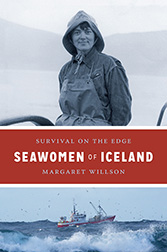Seawomen of Iceland
In her latest book Seawomen of Iceland, anthropologist and former seafarer Margaret Willson shares the country’s rich history and wild beauty through the eyes of the women and men who dedicated their life to the sea.
Her journeys across Iceland, talking to seawomen of today and researching the writings of citizen historians, started when she saw a plaque outside the winter fishing hut of Thurídur Einarsdóttir, a woman who is considered to have been one of Iceland's greatest fishing captains. Einarsdóttir lived from 1777 to 1863, and Willson brings her memory to life recounting the tragic loss of her father, her love affairs and the harsh living conditions of the time.
 Willson then brings to light the many achievements of Icelandic women, and the men they worked alongside, recounting the excitement, accidents, trials, and tribulations of fishing in Iceland from the historic times of small open rowboats to today's high-tech fisheries.
Willson then brings to light the many achievements of Icelandic women, and the men they worked alongside, recounting the excitement, accidents, trials, and tribulations of fishing in Iceland from the historic times of small open rowboats to today's high-tech fisheries.
During the 18th and 19th centuries, many Icelanders lived in near-starvation. Fish were scarce in shallow waters, and people lacked boats that could take them to deeper waters. Many perished in the treacherous seas, and those successful, like Captain (“foreman”) Thurídur Einarsdóttir became symbols of courage and survival.
The nation’s history is very much a history of survival, death, poverty and inequality, and Willson understands and conveys the interconnectedness of life on land and life at sea, as some of the earliest great seawomen were also bonded farm laborers. Even today, the duality of farming and fishing characterizes the survival of the people of Iceland.
Visiting fishing outposts and tiny treacherous harbors, Willson recounts on occasion when a larva flow threatened to block a cherished cove. Rather than stand by, the Icelanders took to their boats and manned pumps, spraying the larva with cold seawater so it would solidify before it hit the sea.
Women were also respected sealers, and were common on the boats. Having a pregnant woman on board was considered desirable, as they were believed to attract seals.
Based on extensive historical and field research, Seawomen of Iceland allows the seawomen's voices to speak directly with strength, intelligence, and - above all - a knowledge of how to survive.
This engaging ethnographic narrative will intrigue both general and academic readers interested in maritime culture, the anthropology of work, Nordic life, and gender studies.
 Margaret Willson is a cultural anthropologist whose current research interests focus on issues relating to Arctic and Northern concerns, including fisheries, gender and small-scale communities. She is affiliate associate professor of anthropology and Canadian studies at the University of Washington and the author of Seawomen of Iceland: Survival on the Edge and Dance Lest We All Fall Down: Breaking Cycles of Poverty in Brazil and Beyond.
Margaret Willson is a cultural anthropologist whose current research interests focus on issues relating to Arctic and Northern concerns, including fisheries, gender and small-scale communities. She is affiliate associate professor of anthropology and Canadian studies at the University of Washington and the author of Seawomen of Iceland: Survival on the Edge and Dance Lest We All Fall Down: Breaking Cycles of Poverty in Brazil and Beyond.
The opinions expressed herein are the author's and not necessarily those of The Maritime Executive.
